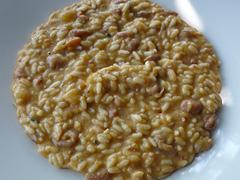Not all rices are the same, however. In this article we will describe the difference between the various types and how it relates to their distinct culinary uses. This will also reveal the secret of the best risotto rices. We will also touch on the fundamental difference between Parboiled (popular in Italy and almost unknown in North America) and Instant rice (almost unknown in Italy).
But, first, what is rice? Rice is the seed of the Oryza sativa grain, or more precisely of one of its two main sub-species: Indica and Japonica. Even though nowadays rice is cultivated almost everywhere in the world (though China, India and Indonesia are by far the biggest producers), rice was first domesticated in tropical Asia as early as 7000 BC. The cultivation slowly expanded westward, and in the 8th century the Japonica specie, which adapted to more temperate climates, reached Europe. It wasn't until the 16th and 17th centuries that rice was introduced to the Americas by settlers from Spain and Portugal.

Rice fields in Piedmont
Rice became widely diffused in Italy during the 15th century. Particularly, it found its most ideal growth conditions in the Po Valley, the vast flatland (650 km long) that surrounds the Po River. Nowadays this area is still at the center of its production.Even though rice is not an aquatic plant and doesn't require submersion in water to grow, rice fields are often completely flooded. This ensures a relatively constant temperature between day and night, which is necessary for this particular grain to develop properly and efficiently.
From a botanical point of view, the rice grain is made of 5 components:

| Chaff
Bran Aleurone layer Cereal germ Endosperm |
To obtain brown rice, the raw grain is milled to remove the chaff. The bran left on the grain gives it the characteristic color and flavor and is responsible for the longer cooking times. For white rice, the milling process is extended to remove the bran, the protein-rich aleurone layer, and the germ. The grain is then polished with fine brushes - a process that also removes oils and enzymes, making the product more stable and easier to preserve.
Compared to brown rice, white rice is lower in fiber and lacks some important nutrients, but it still remains a very complete cereal from a nutritional standpoint. According to the USDA National Nutrient Database, aside from water (12%) and carbohydrates (80%, mostly in the form of starch), it contains significant amounts of proteins (7%), vitamins (B1, B2, B3, B5, B6), and minerals (phosphorous, potassium, calcium, magnesium, zinc, iron).
Parboiled rice (also called Converted rice) is obtained by quickly boiling or steaming the raw grains before milling them. This ancient process has been used for over 2000 years in India and Pakistan, where it's still a common treatment for rice. The process results in a product with higher nutritional value than white rice because some of the vitamins in the bran and germ diffuse into the grain. Its grains are hardened and take longer to cook, but remain intact and separated and are less likely to overcook. They are also more stable, resulting in a product that can be stored in the refrigerator after cooking. Less known in North America, in Italy parboiled rice is commonly used for sides and cold salads ('Insalata di Riso').
Quick-cooking rice (better known as Instant rice or under the brand name 'Minute Rice') is a completely different product. It's either pre-cooked rice that is then dried to cause fissuring so that it will re-hydrate more quickly, or "reconstituted rice" a cooked mixture of rice flour and hydrogenated oils that has been extruded in rice-shaped nodules. These types of rice requires only 5 minutes in hot water to be re-hydrated and ready for consumption, but the nutritional value as well as flavor and texture are seriously compromised. Commonly used in North America, Instant rice exists also in Italy but its market is substantially lower.
Let's now go back to the different types of rice. As we mentioned, all rice contains high amounts of starch, but not all starch is the same. Starch is made of a combination of the non water-soluble amylose and the water-soluble amylopectin: the proportion between the two components determines the properties of the grain.
- Indica rices (e.g.: Basmati) have a high percentage of amylose starch (20-25%) which gives them a firmer structure that can retain high amounts of water (1.4 to 1 by volume). They require relatively long cooking times, the cooked grains remain firm and separated and become hard when chilled.
- Japonica rices have a higher content of amylopectin starch and tend to partially dissolve when boiled. They have faster cooking times and a more limited absorption of water. The cooked grains are stickier and remain tender when chilled. Some Japonica rices have almost no amylose starch ("sticky rice"), whereas some have relatively high amounts (such as the best risotto rices).

1) Basmati rice (Indica, highest amylose, aromatic). Its grains are big, long and thin.2) Carnaroli rice (Japonica, high amylose). Its grains are big but rounder.3) Thai Jasmine (Japonica, medium amylose, aromatic). Its grains are smaller.
In Italy, only Japonica rices are produced. They are classified in 4 categories:
- 'Ordinario' (ordinary) is the least valued type. Short, round grain (length < 5.4 mm). Its low content of amylose starch gives it the shortest cooking times (12-13 min) and the highest amount of starch released in the cooking fluid. It's used to prepare soups, timbales or desserts. Examples are Originario, Balilla, Selenio.
- 'Semi-Fino' (semi-fine). Medium-grain, rounded (length < 6.4 mm); cooks in 13-15 min. Used to prepare broths or dry soups, 'supplì', croquettes, timbales, appetizers and very soft risotti. Examples are: Vialone nano, Lido, Padano.
- 'Fino' (fine). Medium-grain (length > 6.4 mm); cooks in 16 min. Used to make risotti and salads. Examples are: Vialone, Sant'Andrea, Ariete.
- 'Superfino' (superfine) is the variety of the highest quality. Medium-grain (length > 6.4 mm). Its high content of amylose starch gives it longer cooking times (18 minutes) and grains that remain separated. It's the rice preferred for the preparation of sides and risotti. Examples are: Arborio, Carnaroli, Roma.

Piedmontese 'Paniscia', a traditional
risotto with beans, potatoes and sausage.

